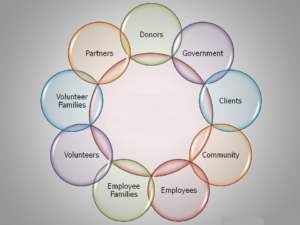I have been an advancement professional for 40 years and have never understood why 501c3 organizations are referred to as “nonprofits” or “tax-exempt.” In addition to not truly reflecting how they work, it is also demeaning and denotes second-class status in our capitalistic society.
My 2024 resolution is to refer to 501c3’s as Stakeholder Organizations (STOrgs). STOrgs, like private sector Shareholder corporations (SHCorps), work for revenues to exceed expenses. After all, that’s a primary reason why STOrgs have advancement programs.
Profit: Net revenue (profit) in SHCorps inures to shareholder equity while it helps STOrgs meet their mission in support of their stakeholders. There is no shame in building financial reserves to fulfill these purposes.
Tax-exempt: Using the term “tax-exempt organization” is also misguided. STOrgs get a pass for taxes on net revenue and, in most cases, property and sales taxes. But they do pay payroll taxes for employees. In many communities, STOrgs are asked to pay a fee in lieu of taxes to contribute to the cost of city services that they use. And let’s not overlook the fact that many SHCorps have found ways to avoid paying tax on their profits for years.
Alignments
When we compare STOrgs and SHCorps, we find both:
- Have boards of directors that provide fiduciary oversight and consultive functions, though SHCorps pay board members for their service.
- Often have a mission statement.
- Are registered with federal, state, and local governments.
- Carry a host of liability insurance coverages.
- Use profit and loss statements and balance sheets to convey financial positions.
- Generate value by providing goods or services to their consumer markets.
- Annually generate net operating revenue or operate in the red.
- Have the majority of its workers in service positions.
- Pay payroll and other taxes, though STOrgs do not pay tax on net revenue or property, and many SHCorps find ways to avoid paying income tax.
- Use philanthropy to further their corporate objectives.
- Deal with human resources issues.
- May offer retirement plans to employees.
You get the point.
Pride: As an important sector in our nation’s economy, we must hold our heads high and refer to ourselves with pride, conviction, and parity with other economic sectors.
Third Sector: The collection of STOrgs is often referred to as the “Third Sector” in contrast to government and private sectors.
According to the Independent Sector, STOrgs comprised 5.6% of GDP and contributed $1.4 trillion to the economy in 2022. The size of STOrgs varies greatly, from small local organizations to large international groups, much like the size variations and reach of SHCorps. The majority of our nation’s nearly one million STOrgs have annual revenues below $50,000, and more than 63,000 have yearly revenues between $1.0 million and $4.9 million, according to Statista. By contrast, government spending in the US was recorded at 37.0 percent of GDP in 2022, according to Trading Economics.
Words are powerful: As an advancement consultant, I’d much rather have donor discussions about how philanthropy elevates the mission of STOrgs and how it benefits stakeholders. Fundraisers should not feel sheepish when discussing their STOrg’s reserve funds with donors. They should ask donors, likely employed in the private sector, if their SHCorp is more robust when they have a strong balance sheet. Their affirmative answer also holds for STOrgs, ensures restricted contributions are protected from being used for emergencies and enhances the likelihood of the STOrgs’ success.
The time has come to change the language of our sector to reflect our importance and value to society.
Will you join me in this New Year’s resolution?


